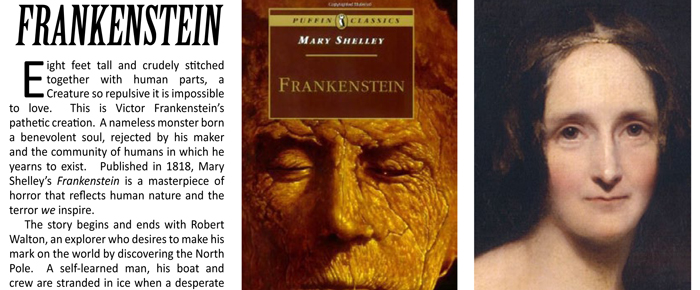
By Heidi Simmons
—–
Frankenstein
By Mary Shelley
Fiction
—–
Eight feet tall and crudely stitched together with human parts, a Creature so repulsive it is impossible to love. This is Victor Frankenstein’s pathetic creation. A nameless monster born a benevolent soul, rejected by his maker and the community of humans in which he yearns to exist. Published in 1818, Mary Shelley’s Frankenstein is a masterpiece of horror that reflects human nature and the terror we inspire.
The story begins and ends with Robert Walton, an explorer who desires to make his mark on the world by discovering the North Pole. A self-learned man, his boat and crew are stranded in ice when a desperate Dr. Frankenstein appears and conscripts Walton’s help to hunt down a vile Creature. Feverish, Frankenstein tells Walton the story of his life and that of his creation.
It begins with the young Frankenstein, an ambitious erudite who leaves his home in Geneva to study philosophy and chemistry in Ingolstadt. He soon masters the subjects and is determined to find the “secret of life.” Abandoned by his professors, he relentlessly pursues reanimating lifeless human matter. When Frankenstein is successful, he is appalled at the Creature he sees and what he has done! Ashamed and horrified, he rejects the very life he was possessed to create.
Quickly becoming self-aware, the Creature runs off but is tormented by the villagers. He has super human strength, but is intuitive and sensitive. Confused and frightened, the Creature takes refuge in a forest where he is able to stealthily observe a loving, considerate family in their small cabin. He secretly aids in their survival and learns to speak and read by studying their behavior. Certain the family would accept him for what he is on the inside and not judge him by his grotesque form, he attempts contact but is sadly misunderstood and beaten. He escapes. His sorrow turns to anger against his maker and the confusing human race.
Now a monster, he hunts down Frankenstein and becomes his tormentor. He kills those close to Frankenstein and demands that the Doctor make him a mate. Frankenstein cannot bring himself to do it again and the Creature unleashes his wrath on what Frankenstein most loves — his beloved bride Elizabeth.
Frankenstein, determined to destroy is own creation, follows — or is lead by — the Monster to the ends of the earth. When the two come face to face, Frankenstein is dead and the Creature cannot bare the sadness of being rejected and unloved by his creator.
Articulate and wise, the Monster confesses his crimes of murder to Walton. The Creature is repelled by his horrific actions but his vengeance on Frankenstein is complete. The Monster bolts from the ship and is free to face his doom. As the ice breaks up, Walton decides to give up his quest for the Pole and return home. It is better to preserve life than to destroy it for personal gain. A lesson he has learned from his brief encounter with Frankenstein and the Creature.
This book is so rich in themes and meaning about life it can provoke hours of conversation. To name a few: The relationship between the creator and the created, nature verses nurture, science and the pursuit of knowledge, beauty, benevolence, technology, immortality, obsession, secrecy, forgiveness, acceptance, happiness, ethical practices, the right to life, free will, love and so on. It’s clear why Frankenstein continues to be an educational staple in the classroom. There is something for everyone in its pages.
Don’t be expecting the iconic “Frankenstein” you may have seen in movies. The Doctor never shouts “He’s alive!” and there is no skewed laboratory harnessing lightening. This is a book about ideas, relationships and metaphysics.
Mary Shelley was only 18 years old when she wrote Frankenstein. She was a daughter of intellectuals and was expected to be a writer. Frankenstein was born out of a competition with her friends that included Lord Byron. Shelly’s narrative is influenced by the Iliad, Shakespeare and Milton’s Paradise Lost. Frankenstein is approaching two hundred years old, and it’s fair to say that Shelley’s material, just as those authors who inspired her, is timeless and will be around for many more years of relevant discussion.
For me, I wonder if perhaps it was not Frankenstein who created the monster, but those who could not see the real beauty of the Creature. As human beings, sometimes we are the Monster and sometimes we are the Maker. The horror is not knowing which we are — and when.











































